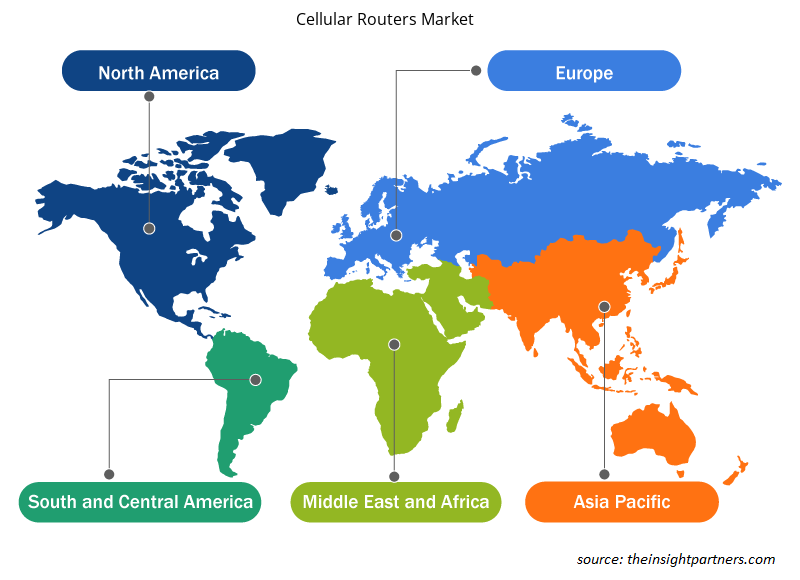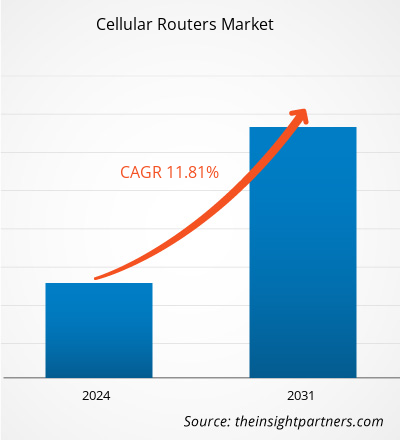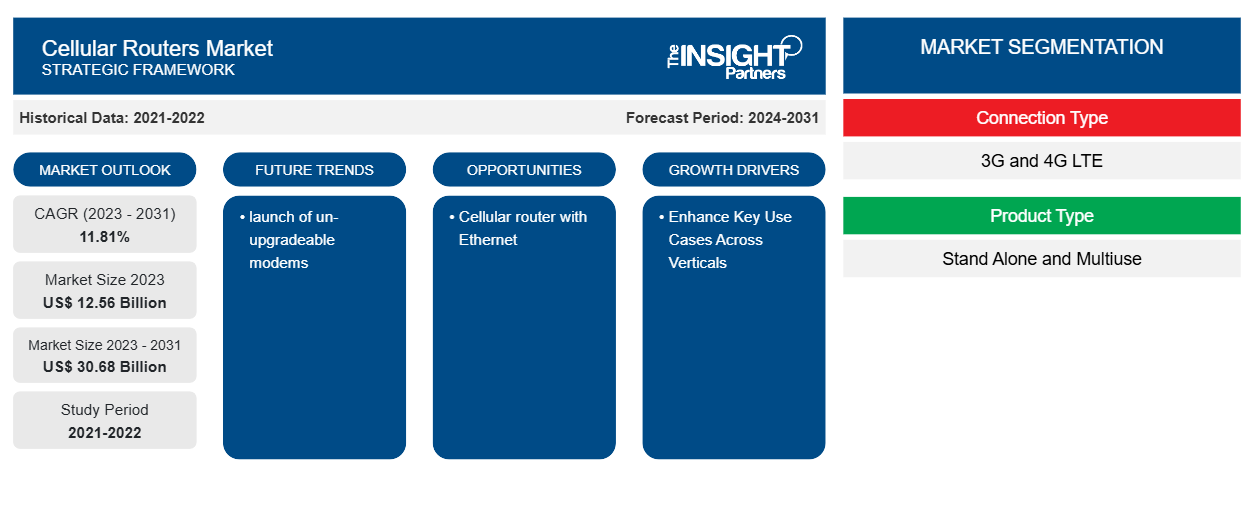蜂窝路由器市场规模预计将从 2023 年的 125.6 亿美元增至 2031 年的 306.8 亿美元。预计 2023-2031 年市场复合年增长率将达到 11.81%。不可升级调制解调器的推出可能仍是市场的主要趋势。
蜂窝路由器市场分析
- 有几个重要方面推动了市场的快速扩张。由于全球 SG技术的发展,对高速和低延迟通信的需求不断增长,推动了 5G 蜂窝调制解调器的全球部署。
- 蜂窝连接越来越多地被集成到各种仪器中,例如物联网设备、智能家居设备和工业设备,从而推动了市场增长。
蜂窝路由器市场概况
- 蜂窝路由器采用蜂窝技术提供互联网连接。对于无法使用有线互联网服务(如电缆或光纤)的企业、家庭和其他地点来说,蜂窝路由器是极佳的选择。
- 这使得蜂窝路由器成为在偏远地区运营或需要在旅行时保持连接的组织和个人的有用工具。
- 它们具有几个主要品质,使其成为移动计算和通信的绝佳选择:千兆速度连接;蜂窝路由器提供高达 5G 和 4G LTE 的快速、可靠的连接,可快速访问流媒体服务和网络应用程序。
- 便携性:蜂窝路由器重量轻,体积小,易于运输和配置。
定制此报告以满足您的需求
您可以免费定制任何报告,包括本报告的部分内容、国家级分析、Excel 数据包,以及为初创企业和大学提供优惠和折扣
-
获取此报告的关键市场趋势。这个免费样品将包括数据分析,从市场趋势到估计和预测。
蜂窝路由器市场驱动因素和机遇
增强垂直行业的关键用例以利于市场发展
- 虽然 wifi 网络是许多企业的标准配置,但蜂窝路由器由于其能够通过蜂窝网络提供无线数据访问的能力,在一系列行业中越来越受欢迎。
- Wifi 路由器在两台设备之间建立无线网络连接(通常通过无线电波),以在短距离内提供高速 wifi。Wifi 通常用于通过连接到宽带有线连接的无线路由器访问互联网。
- 蜂窝路由器利用蜂窝塔提供更长距离的无线互联网连接。它们通常用于通过手机或其他移动设备连接互联网,但它们也可以支持农村地区的广泛网络。这使得它们非常适合不同行业的几个主要用例:零售、医疗保健、交通运输、制造业等。
带以太网的蜂窝路由器
- 许多路由器将互联网无线传输到其 wifi 网络上的所有设备。其他时候,您可能需要使用以太网线将设备连接到路由器。以太网电缆是一种提供有线互联网连接的定制电缆。在 wifi 出现之前,所有互联网连接都需要一根挂在墙上的以太网线。
- 以太网连接通常比 WiFi 提供更快、更稳定的互联网连接。但是,当用户需要移动设备时,它们会很不方便。大多数手机和其他移动设备没有以太网电缆连接,因此您需要购买适配器来连接它们。
蜂窝路由器市场报告细分分析
有助于得出蜂窝路由器市场分析的关键部分是连接类型、企业类型和最终用户。
- 根据连接类型,市场分为 3G 和 4G LTE。
- 根据产品类型,市场分为独立型和多用途型。
- 根据应用,市场分为零售和商业、住宅、工业和运输。
蜂窝路由器市场份额按地区分析
- 蜂窝路由器市场报告包括对五个主要地理区域的详细分析,其中包括当前和历史市场规模以及 2021 年至 2031 年的预测,涵盖北美、欧洲、亚太地区 (APAC)、中东和非洲 (MEA) 以及南美洲和中美洲。
- 每个地区进一步细分为各个国家。本报告提供 18 个国家的分析和预测,涵盖蜂窝路由器市场动态,例如影响区域市场的驱动因素、趋势和机会。
- 此外,该报告还涵盖 PEST 分析,其中涉及影响这些地区蜂窝路由器市场的主要因素的研究。
蜂窝路由器市场区域洞察
Insight Partners 的分析师已详尽解释了预测期内影响蜂窝路由器市场的区域趋势和因素。本节还讨论了北美、欧洲、亚太地区、中东和非洲以及南美和中美洲的蜂窝路由器市场细分和地理位置。

- 获取蜂窝路由器市场的区域特定数据
蜂窝路由器市场报告范围
| 报告属性 | 细节 |
|---|---|
| 2023 年的市场规模 | 125.6亿美元 |
| 2031 年市场规模 | 306.8亿美元 |
| 全球复合年增长率(2023 - 2031) | 11.81% |
| 史料 | 2021-2022 |
| 预测期 | 2024-2031 |
| 涵盖的领域 |
按连接类型
|
| 覆盖地区和国家 |
北美
|
| 市场领导者和主要公司简介 |
|
蜂窝路由器市场参与者密度:了解其对业务动态的影响
蜂窝路由器市场正在快速增长,这得益于终端用户需求的不断增长,而这些需求又源于消费者偏好的不断变化、技术进步以及对产品优势的认识不断提高等因素。随着需求的增加,企业正在扩大其产品范围,进行创新以满足消费者的需求,并利用新兴趋势,从而进一步推动市场增长。
市场参与者密度是指在特定市场或行业内运营的企业或公司的分布情况。它表明在给定市场空间中,相对于其规模或总市场价值,有多少竞争对手(市场参与者)存在。
在蜂窝路由器市场运营的主要公司有:
- Cradlepoint 公司
- Sierra Wireless 公司
- Digi 国际有限公司
- 研华有限公司
- 摩莎公司
- 百通公司
免责声明:上面列出的公司没有按照任何特定顺序排列。

- 获取蜂窝路由器市场顶级关键参与者概览
蜂窝路由器市场新闻和最新发展
通过收集主要和次要研究后的定性和定量数据来评估蜂窝路由器市场,其中包括重要的公司出版物、协会数据和数据库。下面列出了蜂窝路由器市场的一些发展情况:
- 全球网络和连接技术先驱 D-Link 推出了 R15 EAGLE PRO AI AX1500 智能路由器。全新 R15 EAGLE PRO AI 路由器将最新的 wifi 6 技术与人工智能相结合,提供卓越的 wifi 覆盖范围和速度。(来源:D-Link,新闻稿,2021 年 12 月)
- Proscend 推出了一款室外蜂窝路由器,以弥合数字鸿沟。Proscend 室外 4G LTE 蜂窝路由器 M366 专为经济高效、易于部署且灵活的固定无线接入 (FWA) 解决方案而设计。凭借成熟的 4G 网络覆盖,Proscend M366 不仅让居住在有线基础设施无法覆盖的未服务和服务不足地区的家庭受益。(来源:Proscend,新闻稿,2022 年 4 月)
蜂窝路由器市场报告覆盖范围和交付成果
“蜂窝路由器市场规模和预测(2021-2031)”报告对市场进行了详细分析,涵盖以下领域:
- 蜂窝路由器市场规模及全球、区域和国家层面所有主要细分市场的预测
- 蜂窝路由器市场趋势,以及驱动因素、限制因素和关键机遇等市场动态
- 详细的 PEST/波特五力分析和 SWOT 分析
- 蜂窝路由器市场分析涵盖主要市场趋势、全球和区域框架、主要参与者、法规和最新市场发展
- 行业格局和竞争分析,涵盖市场集中度、热图分析、知名参与者以及蜂窝路由器市场的最新发展
- 详细的公司简介
- 历史分析(2 年)、基准年、预测(7 年)及复合年增长率
- PEST和SWOT分析
- 市场规模、价值/数量 - 全球、区域、国家
- 行业和竞争格局
- Excel 数据集
近期报告
相关报告
客户评价
购买理由
- 明智的决策
- 了解市场动态
- 竞争分析
- 客户洞察
- 市场预测
- 风险规避
- 战略规划
- 投资论证
- 识别新兴市场
- 优化营销策略
- 提升运营效率
- 顺应监管趋势























 获取免费样品 - 蜂窝路由器市场
获取免费样品 - 蜂窝路由器市场